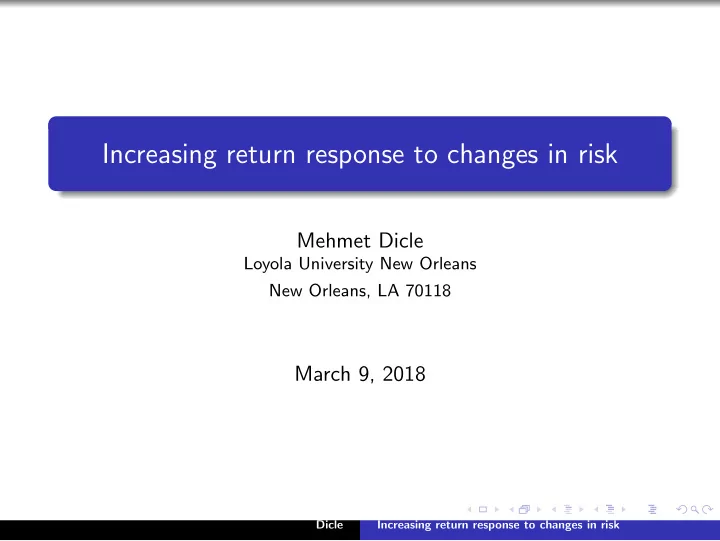

Increasing return response to changes in risk Mehmet Dicle Loyola University New Orleans New Orleans, LA 70118 March 9, 2018 Dicle Increasing return response to changes in risk
Briefly... A positive and marginally diminishing relationship between risk and return exists. This study is about investor behavior as it relates to their response (not choice) to risk. We present an argument and supporting evidence that investors’ return response to risk is increasing in level of risk. Dicle Increasing return response to changes in risk
Risk and return tradeoff There is no doubt about investors seeking higher compensation for higher risk. On a cross section of investment choices, the correlation of risk and return is positive in early evidence. More recently, the evidence is mixed for cross-section as well as for time-series analysis. Based on a recent sample, 2006-2013, this evidence is in direct disagreement with earlier positive risk-return tradeoff evidence in the literature. Dicle Increasing return response to changes in risk
Positive risk and return tradeoff? Dicle Increasing return response to changes in risk
Risk and return tradeoff In terms of bonds, there is no doubt about this positive and statistically significant tradeoff. While stock investors have the same risk-return tradeoff, they cannot possibly know all future payments with certainty. Ex-ante, investors chose stocks based on their possible (predicted or expected) future risk-return schemes. Ex-post, investors realize the risk and returns as they materialize. Thus, any evidence about positive and statistically significant risk-return tradeoff, ex-post, is in effect an evidence of investors success in prediction. Dicle Increasing return response to changes in risk
Risk and return tradeoff Bond prices are present values of all future expected payments. If risk increases investors will decrease (by paying less) bond prices to a matching bond yield. This is also the case for stocks. If stock prices are present values of all future expected payments, much like bonds, then the same yield theory would apply to stocks. As risk increases investors would decrease stock prices to a matching yield. Dicle Increasing return response to changes in risk
Risk and return tradeoff While overall risk and return tradeoff stays positive for cross section of stocks, ex-ante, daily returns would have negative correlation with daily changes in risk on a time series analysis . We provide evidence that the correlation between daily returns and expected risk (implied volatility) is statistically significant and negative for major US equity indexes, international equity ETFs and a few select stocks. Dicle Increasing return response to changes in risk
Daily returns and expected risk (implied volatility) Dicle Increasing return response to changes in risk
Price response to changes in risk We argue that the investors’ risk-return behavior changes when risk is above the “usual” level. It is established that investors in fact overreact to events It is also evident that investors’ risk aversion changes based on habits and overall risk levels. Guiso (2013) show that investors’ risk aversion has increased after the 2008 financial crisis. Effect of fear (fear of financial crash) on further choices made by investors. Dicle Increasing return response to changes in risk
Price response to changes in risk Behavioral sciences offer evidence to this effect with respect to behavior for health risks. Brewer (2004) argues that as individuals’ perception of higher risk leads them to seek protection (i.e. vaccinations). This evidence is supported by Holt (2002) who show that the pay-out has a direct impact on the risk choices of individuals. We argue that investors would be expected to change their response to risk when faced with fear. Dicle Increasing return response to changes in risk
Price response to changes in risk Implied volatility indexes for the equity markets (i.e. VIX) is considered to be the fear gauge. A long run average of the VIX would create a feeling of normality (almost like habit formation). Levels of risk above this long run average would leave investors feeling vulnerable (i.e. in fear). When in fear investors would be expected to react less rationally, more quickly and perhaps in exaggeration. We therefore argue that investors’ price response to increases in risk would be higher for fear periods . Dicle Increasing return response to changes in risk
Price response to changes in risk Given the negative time-series return response to changes in risk, we would expect this negative response to be even more for days when VIX is above its long run average. Our evidence supports this theory. Equities have completely different risk-return tradeoff cross-sectionally for high risk days and for low risk days. They also have significantly lower negative return response to changes in risk for high risk days compared to low risk days. Dicle Increasing return response to changes in risk
Price response to changes in risk Dicle Increasing return response to changes in risk
Price response to changes in risk Dicle Increasing return response to changes in risk
Price response to changes in risk Dicle Increasing return response to changes in risk
Implications Risk-return tradeoff is different for ex-ante and ex-post . While holding period risk-return tradeoff is positive (ex-ante), stocks’ price response to changes in risk is expected to be negatively correlated, much like bonds . This yield theory for stocks would explain the conflicting and mixed results in the literature. Dicle Increasing return response to changes in risk
Implications Investors’ mode of response changes with higher than usual risk levels. It is similar to driving. At higher speeds (i.e. above the usual speed limit), we become more alert, more ready to react and our response would increase. Investors’ reaction to increases in risk is the same. At high levels of risk (i.e. above the usual levels), we become more responsive. Dicle Increasing return response to changes in risk
Recommend
More recommend